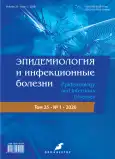Heterogeneity of Salmonella isolates obtained from various sources in Russia 2010–2019
- 作者: Rozhnova S.S.1, Kuleshov K.V.1, Pavlova A.S.1, Guseva A.N.1, Kozhakhmetova T.A.1, Akulova N.K.1, Podkolzin A.T.1
-
隶属关系:
- Central Research Institute of Epidemiology
- 期: 卷 25, 编号 1 (2020)
- 页面: 26-34
- 栏目: Original study articles
- URL: https://journals.rcsi.science/1560-9529/article/view/35184
- DOI: https://doi.org/10.17816/EID35184
- ID: 35184
如何引用文章
全文:
详细
Aim: the goal of the study was to evaluate the heterogeneity of the Salmonella enterica subsp. enterica strains isolated from clinical specimens and various environmental sources in the Russian Federation during the period 2011–2019.
Materials and methods. The data of 3076 non-typhoid isolates of Salmonella obtained from sporadic and outbreak cases of salmonellosis (n = 2518), food and water samples (n = 558) were used. These isolates were serotyped according to the Kaufman–White scheme and genotyped by Pulsed-Field Gel Electrophoresis (PFGE) using XbaI and BlnI restriction endonucleases according to a standard PFGE-protocol developed by PulseNet International Network.
Results. The studied Salmonella isolates were differentiated into 73 serotypes and 601 PFGE types. A comparative analysis of isolates from various sources made it possible to identify subtypes that differed significantly in their prevalence in humans and potential transmission factors (sources). A significant proportion of chicken, turkey, and pork meat samples contained PFGE-subtypes which did not occur in clinical samples. Regional differences in the heterogeneity of the Salmonella spp. were also identified.
Conclusions. Genetic heterogeneity of the Salmonella population from humans and other sources shows significant variability of virulent properties and indicates the necessity of differentiated assessment of their epidemiological potential.
作者简介
Sofia Rozhnova
Central Research Institute of Epidemiology
Email: salm@pcr.ru
ORCID iD: 0000-0002-3009-8593
SPIN 代码: 8888-2294
PhD
俄罗斯联邦, MoscowKonstantin Kuleshov
Central Research Institute of Epidemiology
编辑信件的主要联系方式.
Email: konstantinkul@gmail.com
ORCID iD: 0000-0002-5238-7900
SPIN 代码: 7404-4080
PhD
俄罗斯联邦, MoscowAnastasia Pavlova
Central Research Institute of Epidemiology
Email: epid-oki@pcr.ru
ORCID iD: 0000-0003-4619-9337
SPIN 代码: 7102-1513
MD
俄罗斯联邦, MoscowAnna Guseva
Central Research Institute of Epidemiology
Email: epid-oki@pcr.ru
ORCID iD: 0000-0001-7028-0253
SPIN 代码: 3419-6926
MD
俄罗斯联邦, MoscowTatiana Kozhakhmetova
Central Research Institute of Epidemiology
Email: epid-oki@pcr.ru
ORCID iD: 0000-0002-4821-7992
SPIN 代码: 4942-3575
MD
俄罗斯联邦, MoscowNadezhda Akulova
Central Research Institute of Epidemiology
Email: epid-oki@pcr.ru
ORCID iD: 0000-0003-0208-7165
MD
俄罗斯联邦, MoscowAlexander Podkolzin
Central Research Institute of Epidemiology
Email: epid-oki@pcr.ru
ORCID iD: 0000-0002-0044-3341
SPIN 代码: 8937-5504
MD, PhD
俄罗斯联邦, Moscow参考
- Davis KM, Isberg RR. Defining heterogeneity within bacterial populations via single cell approaches. Bioessays. 2016;38(8):782-90. doi: 10.1002/bies.201500121.
- Magdanova LA, Golyasnaya NV. Heterogeneity as an adaptive trait of microbial populations. Mikrobiologiya. 2013; 82(1): 3-13. (in Russian) doi: 10.7868/S0026365613010072.
- Abee T, Koomen J, Metselaar KI, et al. Impact of pathogen population heterogeneity and stress-resistant variants on food safety. Annu Rev Food Sci Technol. 2016;7:439-56. doi: 10.1146/annurev-food-041715-033128.
- Tsai CN, Coombes BK. The role of the host in driving phenotypic heterogeneity in salmonella. Trends Microbiol. 2019;27(6):508-23. doi: 10.1016/j.tim.2019.01.004.
- The European Union summary report on trends and sources of zoonoses, zoonotic agents and food-borne outbreaks in 2017 European Food Safety Authority and European Centre for Disease Prevention and Control (EFSA and ECDC). EFSA J. 2018; 16(12):e05500. doi: 10.2903/j.efsa.2018.5500.
- Commission Regulation (EU) No 1086/2011 of 27 October 2011 amending Annex II to Regulation (EC) No 2160/2003 of the European Parliament and of the Council and Annex I to Commission Regulation (EC) No 2073/2005 as regards salmonella in fresh poultry meat. Official Journal of the European Union. 2011; 281: 7–11.
- Gerner-Smidt P, Hise K, Kincaid J, et al. PulseNet USA: a five-year update. Foodborne Pathog Dis. 2006;3(1):9-19. doi: 10.1089/fpd.2006.3.9.
- Standard operating procedure for PulseNet PFGE of Escherichia coli O157:H7, Escherichia coli non-O157 (STEC), Salmonella serotypes, Shigella sonnei and Shigella flexneri. Available at: https://www.cdc.gov/pulsenet/pdf/ecoli-shigella-salmonella-pfge-protocol-508c.pdf (accessed 24 March 2020).
- Peters TM. Pulsed-field gel electrophoresis for molecular epidemiology of food pathogens. Methods Mol Biol. 2009;551:59-70. doi: 10.1007/978-1-60327-999-4_6.
- TECHNICAL REPORT ECDC. Roadmap for integration of molecular and genomic typing into European-level surveillance and epidemic preparedness. Version 2.1, 2016−2019. Available at: https://www.ecdc.europa.eu/en/publications-data/ecdc-roadmap-integration-molecular-typing-and-genomic-typing-european-level (accessed 24 March 2020).
补充文件






